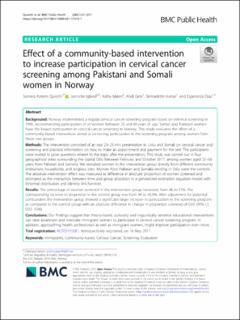| dc.contributor.author | Qureshi, Samera Azeem | |
| dc.contributor.author | Igland, Jannicke | |
| dc.contributor.author | Møen, Kathy Ainul Mashrooka | |
| dc.contributor.author | Gele, Abdi | |
| dc.contributor.author | Kumar, Bernadette | |
| dc.contributor.author | Diaz, Esperanza | |
| dc.date.accessioned | 2021-11-01T07:58:14Z | |
| dc.date.available | 2021-11-01T07:58:14Z | |
| dc.date.created | 2021-08-25T09:08:48Z | |
| dc.date.issued | 2021 | |
| dc.identifier.citation | BMC Public Health. 2021, 21 (1), 1-10. | en_US |
| dc.identifier.issn | 1471-2458 | |
| dc.identifier.uri | https://hdl.handle.net/11250/2826702 | |
| dc.description.abstract | Background Norway implemented a regular cervical cancer screening program based on triennial screening in 1995, recommending participation of all women between 25 and 69 years of age. Somali and Pakistani women have the lowest participation in cervical cancer screening in Norway. This study evaluates the effect of a community-based intervention aimed at increasing participation in the screening program among women from these two groups. Methods The intervention consisted of an oral 20–25 min presentation in Urdu and Somali on cervical cancer and screening and practical information on how to make an appointment and payment for the test. The participants were invited to pose questions related to the topic after the presentation. This study was carried out in four geographical areas surrounding the capital Oslo between February and October 2017, among women aged 25–69 years from Pakistan and Somalia. We recruited women in the intervention group directly from different community institutions, households, and religious sites. Women from Pakistan and Somalia residing in Oslo were the controls. The absolute intervention effect was measured as difference in absolute proportion of women screened and estimated as the interaction between time and group allocation in a generalized estimation equation model with binomial distribution and identity link function. Results The percentage of women screened in the intervention group increased, from 46 to 51%. The corresponding increase in proportion in the control group was from 44 to 45.5%. After adjustment for potential confounders the intervention group showed a significant larger increase in participation in the screening program as compared to the control group with an absolute difference in change in proportion screened of 0.03 (95% CI; 0.02- 0.06). Conclusions Our findings suggest that theory-based, culturally and linguistically sensitive educational interventions can raise awareness and motivate immigrant women to participate in cervical cancer screening program. In addition, approaching health professionals as well as immigrant women, might improve participation even more. | |
| dc.language.iso | eng | en_US |
| dc.rights | Navngivelse 4.0 Internasjonal | * |
| dc.rights.uri | http://creativecommons.org/licenses/by/4.0/deed.no | * |
| dc.title | Effect of a community-based intervention to increase participation in cervical cancer screening among Pakistani and Somali women in Norway | en_US |
| dc.type | Peer reviewed | en_US |
| dc.type | Journal article | en_US |
| dc.rights.holder | Copyright © 2021, Authors | |
| dc.description.version | publishedVersion | |
| cristin.ispublished | true | |
| cristin.fulltext | original | |
| cristin.qualitycode | 1 | |
| dc.identifier.doi | 10.1186/s12889-021-11319-1 | |
| dc.identifier.cristin | 1928548 | |
| dc.source.journal | BMC Public Health | en_US |
| dc.source.volume | 21 | en_US |
| dc.source.issue | 1 | en_US |
| dc.source.pagenumber | 1-10 | en_US |

